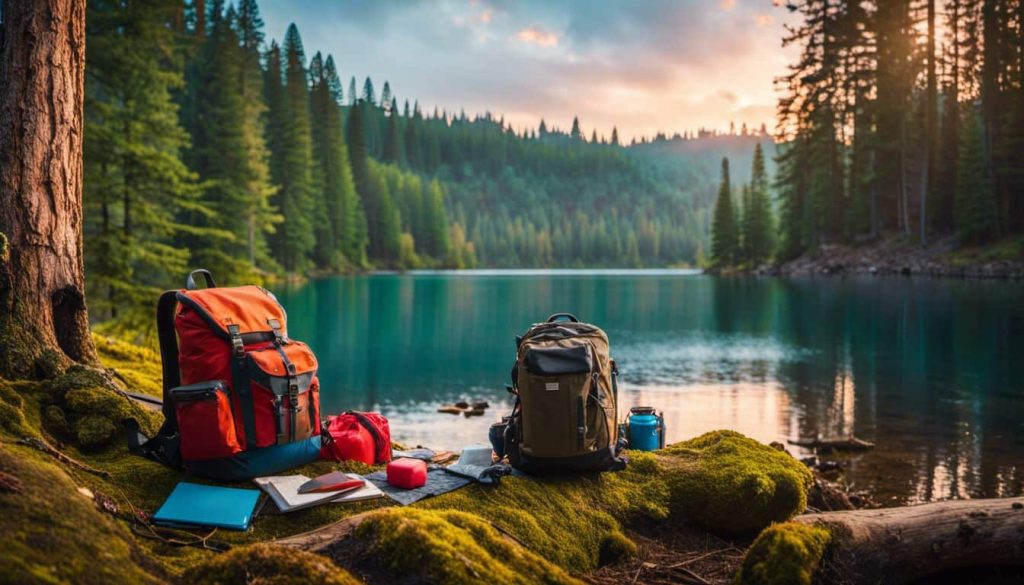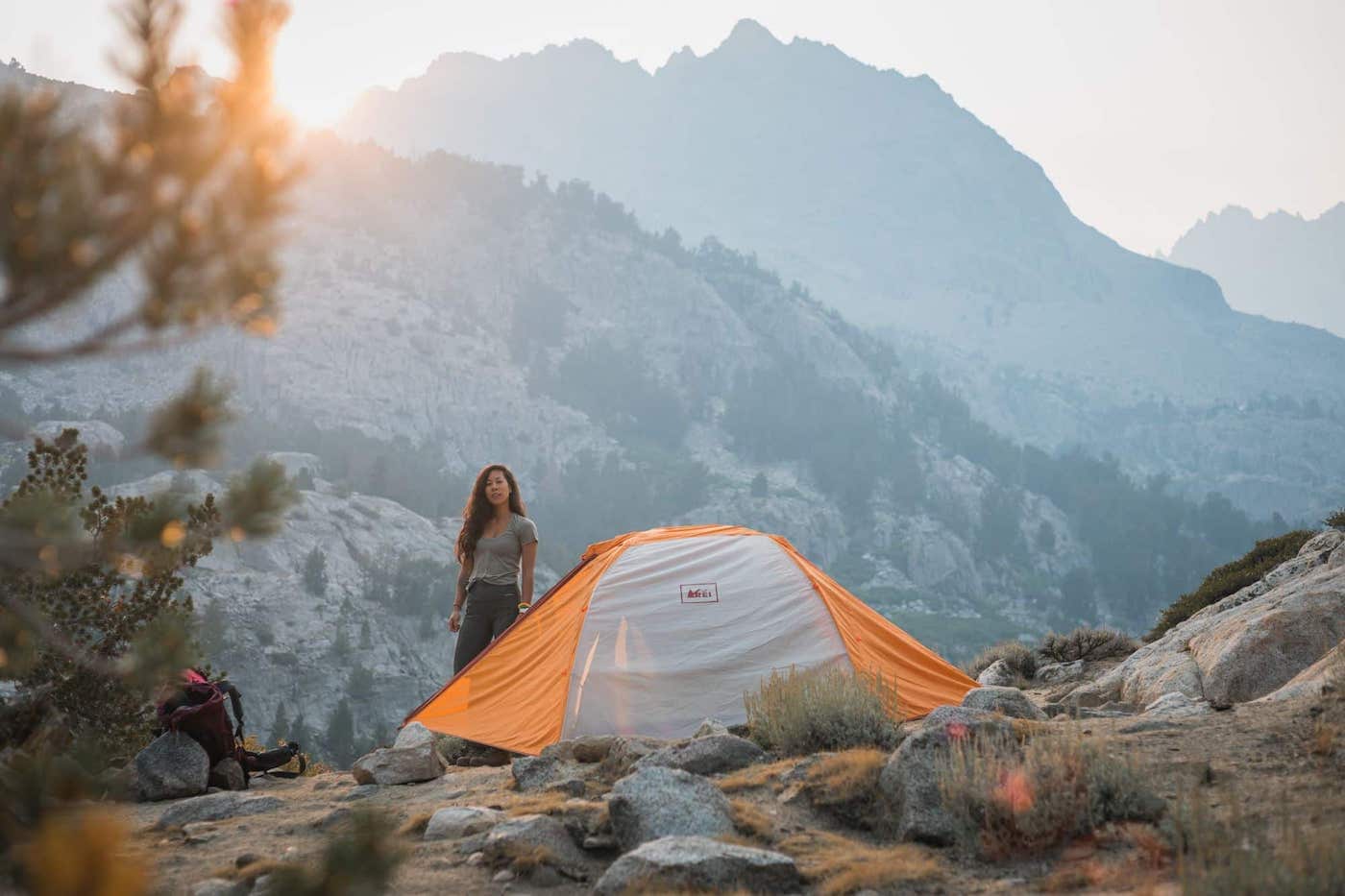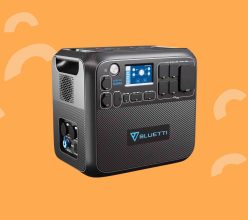
Backpacking brings us closer to nature, challenges our limits, and fosters a sense of freedom and self-reliance.
Are you eager to discover the great outdoors? Backpacking is an exciting way to explore nature and challenge yourself. It’s physical, immersive and accessible to anyone at any skill level. However, the longer the backpacking trip, the more preparation and research is required.
That said, our Ultimate Guide To Backpacking helps readers efficiently plan their backpacking trip, with information and tips on the important questions like, how to choose your destination, what gear and supplies to bring and how to pack. Let’s jump in!
Key Takeaways
- Planning is everything: From choosing your destination, researching trails, and making sure you have all the required permits – advance planning will make your backpacking trip smoother and more fun!
- Invest in good gear: Your backpacking gear, including backpack, sleeping gear, ultralight tent, cooking utensils, clothing, and first aid, are important tools in your journey.
- Learn navigation skills: Get familiar with reading maps and using a compass. You’ll need to know how to locate your position and identify landmarks in new environments.
- Respect nature: Remember to “Leave No Trace” so there’s no impact on the environment. Respect nature and wildlife while you’re enjoying the beauty of nature.
- Have fun and enjoy the journey! Backpacking is not just about reaching the destination, it’s about enjoying the journey. Take time to smell the flowers and soak up the beauty around you.

Why Go Backpacking?
It’s not just about lacing up your boots, hoisting a pack on your back, and stepping out into the wilderness – there’s a ton of amazing benefits that come with backpacking!
Benefits of Backpacking:
- It’s healthy for your body and mind:
- Backpacking is a great workout! Hiking, climbing, scrambling across rocky surfaces – all these things strengthen your muscles, improve heart health and increase stamina. Plus, being outdoors in the fresh air is great for your mental health, reducing stress and increasing a sense of well-being.
- Personal growth:
- Backpacking often takes you out of your comfort zone because it challenges you physically and mentally with both physical and mental challenges. Whether it’s navigating a tricky trail, pitching a tent, or just cooking a meal outdoors, you learn new skills and become more self-reliant.
- Connection with nature:
- In a world dominated by technology, backpacking allows you to unplug and unwind. It’s a chance to appreciate nature and encounter wildlife in their natural habitat.
The world of backpacking is diverse, attracting people at all fitness and experience levels. Whether you’re looking for a multi-day adventure or afternoon retreat, backpacking has something to offer everyone. The journey might be tough at times, but the rewards are worth the effort!
How to Prepare for Backpacking
Spend time researching the best backpacking destination, plan out an itinerary and figure out your budget to make sure you have everything covered for a successful journey.
How to Choose Your Backpacking Destination
Your first important decision before your backpacking trip even starts is to figure out where to go. Selecting the right location can make or break a trip, and so it’s important think about budget, gear, weather, and level of difficulty required when choosing your destination.
For example, if you’re new to backpacking, you probably don’t want to hike the Pacific Coast Trail, which is hundreds of miles long and take weeks or even months to complete. You may also want to avoid trips that have lots of big inclines or are in areas with rainy weather.
Come up with a shortlist before settling on one place. Read guidebooks, search online or ask fellow backpackers for recommendations.
Think About the Experience
It’s important to know what type of experience you want to get out of your backpacking trip in advance.
Do you want an isolated, backcountry experience? Are you planning a fun family trip for people of all ages? Perhaps you’re an expert and want to push your skills to the limit?
Define your goals at the start so that you can plan accordingly and set yourself up for success. You can improve your backpacking trip by creating SMART Goals:
- Specific (which route do you plan on taking).
- Measurable (How many miles do I intend to cover each day).
- Achievable (Can I realistically cover this amount of distance with my current skillset).
- Relevant (Does this goal fit in with my overall goals for the trip).
- Timely/Time-bound (What time-frame have I established for completing the trek).
Popular Backpacking Trips
- Best Backpacking Trails in the US
- A Guide to the Best Yosemite Backpacking Trails
- Best Backpacking in Colorado: 14 Scenic Trips Worth Exploring
- The Best California Backpacking Trips for Adventure Junkies
- The Best Backpacking In Washington
Tips for planning your backpacking trip:
- Research Trails and Permits:
- Educate yourself about the trail you’ll be hiking.
- Research online, study topographical maps, and trail descriptions.
- Some trails require permits in advance, so make sure to check the regulations before you leave.
- Research the Weather:
- The weather can greatly impact your trip.
- Check the forecast in the days before your trip and be prepared for any conditions.
- Remember, weather in mountainous and forested areas can change rapidly.
- Create an Itinerary:
- Plan your daily mileage based on your fitness level and the terrain.
- Also, identify potential campsites along the trail.
- Share your itinerary with someone who’s not on the trip, so they know where you’ll be and when to expect your return.
- Pack Smart:
- What you carry on your back can make or break your trip. We’ll delve deeper into packing in a later section, but always aim for lightweight, multi-use items.
Backpacking Gear and Essentials – What to pack
An big part of backpacking is having the right gear, and “The Big 4” are crucial. The Big 4 refer to your backpack, sleeping bag, sleeping mat or pad, and tent—the most important pieces of backpacking gear.
When choosing your gear, the balance between weight and function is crucial. The goal is to carry as little weight as possible, while still bringing everything you need.
In addition to the Big 4, other useful gear includes clothing, cooking supplies, hiking shoes, safety equipment, and hydration tools.
Backpack
Your backpack holds most everything you bring, so it needs to be comfortable, functional and weather resistant. Also, some backpacks are designed for male or female bodies – pay attention to these details.
| Preview | Product | Rating | Price | |
|---|---|---|---|---|
| | Deuter Unisex – Adult's Futura 32 Hiking Backpack, Graphite Shale, 32 L | $172.55 | Buy on Amazon | |
| | Osprey Rook 65L Men's Backpacking Backpack, Black | $232.97 | Buy on Amazon | |
| | Osprey Renn 65L Women's Backpacking Backpack, Aurora Purple | 1,309 Customer Reviews | $155.14 | Buy on Amazon |
| | Earth Pak Waterproof Backpack - Heavy Duty Roll-Top Closure with Easy Access Front-Zippered Pocket... | $66.65 | Buy on Amazon |
Here are some details to consider when choosing your backpack:
- Size: Backpack sizes are measured in liters, and the right size for you depends on the length of your trip and how much gear you plan to carry. For most beginners, a 50-70 liter bag is a good starting point for a 2-3 day trip.
- Fit: A well-fitted backpack can make the weight you’re carrying feel lighter. Look for something that matches your torso length and has a comfortable, adjustable hip belt since your hips should carry most of the weight – not your shoulders.
- Features: Look for useful features like a rain cover, adjustable frame, storage pockets, attachment points for gear like trekking poles or a sleeping pad, and a hydration reservoir.
- READ: Sustainable Backpacks
Tent
Bring a weather-resistant, lightweight backpacking tent that’s easy to carry and provides enough space to protect you and your gear.
Cooking Gear
Cooking is another important part of your trip, and you’ll need portable cookware that easy to carry and use.
- Stove: There are different types of camping stoves, including canister stoves, liquid fuel stoves, and alcohol stoves. Canister stoves are the most popular because they’re simple, light weight, and cook food quickly.
- Cookware: A single pot or pan may be all you need. Look for lightweight materials like aluminum or titanium.
- Utensils: Bring a lightweight spoon or spork. Some backpackers also carry a small, sharp knife for food prep.
Food
When it comes to the food that you bring, you’ll want to plan your daily meals in advance to ensure you’re packing enough of the right items.
You need complex carbs, proteins, healthy fats, sodium, and natural sugars to maintain calories and nutrients. Here are some recommendations for food:
- Nuts: Pistachios, peanuts, cashews, macadamias all provide protein and healthy fat
- Granola: Full of complex carbohydrates and packed with fiber
- Jerky: High in protein with little fat and few carbohydrates
- Dried Fruits: Provide quick energy, antioxidants and vitamins
- Protein Powder or Dairy Alternatives: Mix powder into yogurt for a snack high in calories
- Pouches of Tuna or Salmon: Lightweight source of protein
- Bars such as Clif Bars or Luna Bars: Rich in antioxidants and easy to carry
- Olive Oil Packets (or similar): These can be used as dressings or added directly into dishes for flavor and essential fatty acids
- Trail Mix or Trail Snacks: Great pre-prepared combination of nuts, grains, dried fruit and chocolate chips
- Sodium Sources such as Himalayan Salt Packets (or similar): Include these to balance electrolyte levels.
Hiking Footwear
The hiking socks, boots and shoes that you bring need to be carefully considered to make sure they’re perfectly tailored to both your feet and backpacking trip.
Invest in hiking footwear that offer ankle support, traction, and waterproofing. Also, make sure to break them in before your trip. There are important details to consider in order to choose the right pair:
- Comfort: You want comfortable hiking shoes that can handle the environment. It’s important to make sure your footwear fits well and doesn’t cause you discomfort or pain. Wear them for several days/weeks in advance to make sure.
- Foot type: The shape and structure of your feet are super important when choosing hiking boots or shoes. Consider what type of support your feet need in order to hike in a healthy way that doesn’t cause any damage.
- Footwear design: You can choose hiking boots or hiking shoes, and both styles offer different level of protection and support. After you understand your foot type, think which type of footwear will best suit your needs.
- Injuries: If you’ve had foot or ankle injuries in the past, it’s important to choose footwear that will give you right level of support and protection.
- Gear and body weight: The weight of your gear and your body weight impacts your footwear. If you’re carrying a heavy load, you might need more support and than if you’re hiking with a light pack.
- Environment: Different types of terrain and weather require different types of hiking footwear, so make sure to select boots or shoes that are right for the environment that you’ll be hiking.
- Hiking socks: Socks are one of the most important – an overlooked – pieces of hiking gear. Choosing the wrong socks can wreck your backpacking trip, and potentially your feet. Consider features like breathability, ankle length, thickness and weather resistance.
- READ: Sustainable Hiking Shoes Made From Recycled Materials »
Sleeping Gear
Your sleeping bag and sleeping pad are part of the “Top 4” backpacking gear. They provide warmth, protection and the rest that you’ll need after hiking for hours each day.
- Sleeping Bag: Choose a sleeping bag rated for the lowest temperature you expect to encounter. Bags are usually filled with down (light, efficient, expensive) or synthetic materials (heavier, bulkier, cheaper). A mummy-style bag is a good option as it offers the best warmth-to-weight ratio.
- Sleeping Pad: A sleeping pad provides insulation from the ground and cushions you for a comfortable sleep. Pads come in air, self-inflating, and closed-cell foam styles, each with their pros and cons.
- Optional – Pillow: Some backpackers prefer to bring a small, inflatable camping pillow for added comfort, but it’s not necessary. You can also use your clothes as a makeshift pillow.
- READ: Non-Toxic Slumber with PFA / PFC-Free Sleeping Bags »
- READ: Sleep Green: A Guide to Building Your Own Eco-Friendly Camping Bed »
Portable power station (optional)
If you’d like to have access to electricity while you’re on the go, consider bringing a portable power station and portable solar panels to charge gear like smartphones, lights and cookware.
Hiking Clothing
It’s important to dress appropriately on your backpacking trip to make sure you’re protected from the elements. This includes sun, wind, rain and temperature changes.
Layering your clothing is helpful in regulating body temperature, without significantly increasing your pack load.
Long sleeve shirts and long pants designed to repel insects can protect against bites when backpacking in areas like Northeastern forests where there’s a lot of mosquitoes and ticks. Consider bringing items like a down jacket, windbreaker, and rain jacket so you can easily adapt to changes while out on the trail.
Here’s what you’ll need to consider:
- Base layer shirts and leggings that can be layered under your clothing. Start with a moisture-wicking base layer, add an insulating middle layer, and finish with a waterproof and windproof outer layer.
- Hiking shirts and pants. Avoid cotton. Instead, opt for UV resistant clothing made from synthetic materials, which wick sweat away, provide warmth and dry quickly if you get wet.
- Down jacket, windbreaker or rain jacket
- Extras: Don’t forget a hat or cap for sun protection, gloves for warmth, and a rain jacket in case of sudden showers.
Safety & First Aid
It’s important to be prepared for unexpected abrasions and cuts when you’re outdoors. A well planned safety kit provides a layer of support when you’re far away from emergency services.
Here’s what you should consider having in your first aid kit:
- First Aid Kit: Carry a lightweight first-aid kit with essentials like bandages, antiseptic wipes, tweezers, aspirin, ibuprofen and any necessary prescription medications.
- Multitool: A multitool is handy for tasks like cutting cords, opening packages, or making gear repairs.
- Headlamp: A headlamp helps you navigate and set up camp in the dark. Don’t forget extra batteries!
- Fire starter: Waterproof matches, a lighter and fire starter in case you need to start a fire in wet conditions.
- Emergency Blanket or Tarp: An emergency blanket or tarp could be a lifesaver in case your main tent gets damaged.
- READ: Camping Tools Kit: 10 Essential Gadgets For a Successful Camping Trip »
Getting mentally and physically fit
Before heading out on a backpacking trip, make sure that you’re both mentally and physically prepared.
Mental and physical preparation tips
- Cardio Prep: Begin with activities that get your heart rate up – think walking, running, cycling, or swimming. Try to incorporate at least 30 minutes of cardio into your routine three to four times a week. As you get fitter, start adding weight to mimic all the gear you’ll be carrying and include hilly terrain in your workout to simulate trail conditions.
- Strength Training: Focus on exercises that strengthen your legs, back, and core. Squats, lunges, step-ups, planks, and deadlifts can be excellent choices. Remember, you’ll be carrying a pack that may weigh anywhere from 20 to 40 pounds, depending on your trip, so building strength is crucial.
- Calisthenics and Stretching: Don’t overlook flexibility! Stretching after your workouts can reduce muscle soreness and improve your overall mobility on the trail. Yoga can be a great way to enhance flexibility and balance.
- Hiking: The best training for backpacking is, well, hiking! Try to go on regular day hikes, gradually increasing the distance and elevation gain. It’s a fun and practical way to prepare your body for the trail.
Practice Hiking with Weight
Practicing hiking with weight is essential before heading out on a backpacking trip. Hiking with a weighted pack not only helps strengthen the body and build endurance, but also helps condition it for long hikes.
By carrying extra weight on your back you can tone your legs, core muscles, improve posture and posture control while walking for hours at a time. Practicing with weights will also give you an idea of how heavy or light your total backpack should be when going for longer trips to prevent any kind of unexpected injuries.
It is recommended that hikers monitor their heart rate every hour during practice hikes in order to help spot signs of exhaustion which can lead to injury if ignored and thus ensure safe outings into the wild!
Strengthening Your Legs
Having strong legs and good balance are essential to backpacking success. Without proper leg strength, you run the risk of injury and fatigue on the trail—so it’s important to invest in building your leg muscles before you hit the trails.
Exercises like calf raises, squats, bridges and planks- can help strengthen your thighs, calves and ankles which support your whole body when you hike or carry a heavy load.
Additionally, doing downhill hiking is an effective way to increase ankle mobility which helps reduce the risk of turning or twisting ankles while on uneven terrain. To stay motivated during training times try adding biking or swimming so you don’t get bored or burned out.
Including Elevation Gains in Training
When preparing for mountainous terrain, it’s important to build endurance and stamina, which can be helpful when climbing difficult uphill trails.
This kind of training strengthens your legs and lungs by mimicking the experience of hiking up steep inclines and down steep descents. An increase in physical fitness will improve overall performance on the trail, while also helping prevent or reduce any risk of injury that might occur from strenuous activity at high altitude.
Developing Mental Flexibility
Being mentally flexible is an essential skill for a successful backpacking trip. It involves having the ability to adapt quickly and easily to new environments, adjust plans based on changing circumstances, and maintain an open-minded attitude.
Mental flexibility also helps with problem-solving skills, such as figuring out alternative ways of reaching objectives when unforeseen obstacles arise. When it comes to decision-making while on the trail, being able to assess all options calmly can make it much easier to choose what’s best in any given situation – something that will be especially important for difficult Summit Days or Pass Possibilities.
Practice Good Backpacking Etiquette
Backpacking etiquette refers to the set of unwritten rules and guidelines that backpackers follow to ensure a positive and respectful experience for themselves, other hikers, and the environment.
Principles of backpacking etiquette:
- Leave No Trace: This is the fundamental principle of outdoor ethics. Pack out all trash, including food scraps, and leave natural and cultural features undisturbed. Minimize your impact on the environment by following the seven principles: plan ahead, camp and travel on durable surfaces, dispose of waste properly, leave what you find, minimize campfire impacts, respect wildlife, and be considerate of other visitors.
- Respect wildlife: Observe animals from a distance and do not disturb their natural behavior. Do not feed wildlife, as it can disrupt their natural diet and behavior, and can also be dangerous for both you and the animals.
- Yield to others: When you encounter other hikers on the trail, yield to uphill hikers and let them pass. Step aside and make way for faster hikers. Be courteous and share the trail with others.
- Keep noise levels down: Many people go backpacking to enjoy the peace and quiet of nature. Respect the silence by keeping noise levels to a minimum.
- Respect camping etiquette: When choosing a campsite, follow stated guidelines and regulations, respect quiet hours and be mindful of your neighbors and the surrounding area.
- Be considerate with campfires: If campfires are permitted, use established fire rings or pits and ensure the fire is completely extinguished before leaving the area.
- Share water sources: Water is a precious resource on the trail, so be considerate and don’t monopolize water or leave the area in poor condition. Always filter or treat water to avoid contamination.
- Respect private property and local communities: Stay on designated trails and respect private property boundaries. When passing through or staying near local communities, be respectful and follow local rules and regulations.
- READ: Eco Camping: 7 Important Principles to Leave No Trace
Learn Important Backpacking Skills
Knowing how to navigate is a crucial skill in the wilderness. Even on well-marked trails, things can go awry, and being able to find your way is key. Here’s what you need:
Map Reading and Compass Use
Being able to navigate using a map and compass is a fundamental outdoor skill. GPS and smartphones are great tools, but electronics can fail. A map and compass are reliable, don’t require batteries, and are lightweight to carry. Here’s how to get started:
Understanding the Map: Familiarize yourself with the basic components of a topographic map, including:
- Scale: Indicates the relationship between a certain distance on the map and the actual distance on the ground.
- Contour Lines: Show the shape and elevation of the terrain. Closer lines indicate a steep slope, while lines spaced further apart represent a gentle slope.
- Legend: Decipher the map symbols and colors to understand features like water bodies, trails, campgrounds, and more.
Using the Compass: Learn to take a bearing, which is the direction from your current position to your destination, expressed in degrees from North. Here’s a basic process to follow:
- Align the Edge: Line up the edge of the compass with your current position and your destination on the map.
- Rotate the Bezel: Twist the compass bezel so that North (usually marked by ‘N’ or ‘0°’) on the bezel aligns with North on the map.
- Read the Bearing: The bearing is the number indicated where the direction of travel arrow intersects the bezel.
Identifying Landmarks
Landmarks, or features that are easily recognizable and visible on a map, are essential for navigational purposes. They can include features like mountain peaks, lakes, trail junctions, or significant changes in the landscape.
Knowing how to identify and use landmarks is a key skill in “terrain association”, the ability to determine your position based on the terrain around you. Here’s how to use landmarks:
- On the Map: Start by identifying landmarks on your map and noting their relationship to each other. This will give you a mental picture of what you should expect to see as you travel.
- In the Field: As you hike, continuously scan the landscape around you for those landmarks you’ve identified on the map.
- Relate the Two: Use the observed landmarks to confirm your position on the map. If what you’re seeing matches up with what’s on the map, you’re in good shape! If not, stop and reassess.
Learning to read a map, use a compass, and identify landmarks may seem a bit daunting at first, but with practice, these skills will become second nature. And they just might save your day when the trail gets confusing or visibility gets poor. Always remember, “The trail is the means, not the end.” Enjoy your adventure!
Tips and Tricks
After you’ve prepared yourself physically, gathered your gear, and planned your trip, here are some practical tips and tricks to make your adventure smoother and more enjoyable.
Packing Your Backpack
Packing your backpack efficiently is an art that improves with practice. The aim is to distribute weight evenly, ensuring stability and comfort on the trail. Here are some basic principles to follow:
Here are some tips to help you pack your backpack:
- Make a packing list: Create a comprehensive packing list to ensure you don’t forget any essential items. Divide your list into categories like clothing, sleeping gear, cooking equipment, personal items, and first aid. This will help you stay organized and prevent overlooking important items.
- Prioritize essential items: Pack your most important and frequently used items at the top or in easily accessible pockets. This includes your map, compass, snacks, water bottles, rain gear, and any essentials you may need during the hike. It’s always a good idea to carry at least two of any essential items, just in case one gets damaged.
- Use packing cubes or dry bags: Utilize packing cubes or dry bags to organize and separate your gear. Group similar items together, such as clothing, toiletries, and cooking equipment, and place them in separate compartments or bags. This makes it easier to locate specific items without unpacking your entire backpack.
- Pack strategically: Distribute weight evenly throughout your backpack to maintain balance and stability. Place heavier items closer to your back and towards the center of the pack to optimize weight distribution. This helps reduce strain on your back and allows for better maneuverability.
- Pack according to accessibility: Consider the frequency of use when packing your gear. Items you’ll need throughout the day, such as snacks or a rain jacket, should be easily accessible. Less frequently used items can be packed deeper in the backpack.
- Secure loose items: Use compression straps or additional cords to secure any loose items to the outside of your backpack. This can include sleeping pads, trekking poles, or a tent. Ensure they are tightly secured to prevent shifting or dangling during the hike.
- Consider weather conditions: Pack appropriate clothing and gear based on the anticipated weather conditions. Layer your clothing and place frequently used items on top. Pack a waterproof or breathable layer on the outside for easy access in case of rain.
- Test your pack: Before heading out on your trip, put on your fully packed backpack to ensure it feels comfortable and properly balanced. Adjust the straps and hip belt for a snug and secure fit. Take a short walk or hike to test the weight distribution and make any necessary adjustments.
- Heavy Items: Pack your heaviest items (like your food stash and cooking kit) close to your back and centered in your pack. This helps keep your center of gravity close to your body, which improves balance.
- Medium Weight Items: Sleeping gear and clothing can be packed around the heavier items. These can help cushion the weight and prevent heavy items from shifting.
- Light Items: Items like your first-aid kit, toiletries, and other small gear can be packed in the top or outer pockets for easy access.
- READ: How to Pack a Backpack for Camping: The Ultimate Guide »
Don’t forget to use your pack’s compression straps to stabilize the load, and always double-check that your pack is comfortable when fully loaded before you set out.
Camp Setup and Teardown
Setting up and tearing down your camp efficiently can make your backpacking trip much more enjoyable. Here’s how:
- Choosing a Campsite: Look for established sites that are flat, dry, and not under trees with dead branches. It’s always best to camp at least 200 feet away from lakes and streams to protect water sources.
- Setting Up Your Tent: Make sure to set up your tent before it gets dark. Clear the ground of sharp objects, lay out your groundsheet, and stake the tent down securely.
- Camp Cleanup: When breaking down camp, follow the Leave No Trace principle. Pack out all your trash and ensure the campsite is clean for the next camper or for nature to reclaim.
Cooking on the Trail
Cooking in the wilderness can be a joy with a little preparation. Here are some tips:
- Meal Planning: Plan your meals in advance and pack food that’s lightweight, easy to cook, and nutritionally dense.
- Cook Safely: Cook and store your food away from your sleeping area to reduce the chance of attracting animals. Always remember to properly extinguish your cooking fire or stove.
- Clean Up: Clean your dishes and cooking utensils thoroughly. Dispose of dishwater at least 200 feet away from water sources.
Wildlife Encounters
Backpacking often brings opportunities to see wildlife in their natural habitat. While these experiences can be a highlight, safety should always be a priority.
- Making Noise: Make noise as you hike to avoid surprising animals.
- Keep Your Distance: Always observe wildlife from a distance and never approach or feed animals.
- Bear Safety: In bear country, carry bear spray, know how to use it, and store your food and scented items in a bear-resistant canister or hang it in a tree away from your campsite.
Beginner-Friendly Backpacking Destinations
Take your backpacking journey to the next level by exploring some of the most spectacular and accessible trails in USA, Switzerland or Spain. Explore now!
Pacific Crest Trail
The Pacific Crest Trail (PCT) is a nearly 2,700-mile long trail that offers spectacular views and challenges along the West Coast of the U.S. From Mexico to Canada, this expertly-graded path is widely considered one of the world’s best long-distance trails due to its breathtaking beauty and variety of environments it passes through.
Thru-hiking the PCT typically takes about 5 months during the snow-free season but backpackers looking for beginner friendly backpacking destinations can still get a taste as resupply points are available throughout many sections on the trail.
Regardless if you’re looking for an epic adventure or simply wanting to experience some of America’s wildest terrains, take heed in knowing that trekking along these legendary paths come with all sorts of rewarding experiences without having to commit months out at once!
Tour du Mont Blanc
The Tour du Mont Blanc is an incredible backpacking trip across 3 countries: France, Italy, and Switzerland. This 180km trek circles Western Europe’s highest peak, Mont Blanc. With huts and accommodations along the route, this beginner-friendly tour can be completed without camping and offers stunning views of the Alps throughout the journey.
Hikers on this trail have access to fresh-baked treats from high huts dotting the way as well, a great bonus for weary travelers! The Trail du Mont Blanc has something for everyone with its easy terrain and variety of experiences—from peaceful mountain lakes to quaint villages with delicious food options.
Whether you plan it as part of a larger adventure or make it into your next vacation spot alone or with friends – there’s no denying that this gorgeous destination makes any journey even more memorable!
Other Recommendations
With so many incredible backpacking destinations out there, even the avid backpackers can find themselves asking “Where should I go?” To help answer this question, here’s a list of some amazing beginner-friendly backpacking destinations:
- Appalachian Trail: Stretching from Georgia to Maine and spanning over 2,000 miles, the Appalachian Trail offers myriads of sites and settings for adventurers of all levels. From waterfalls to grassy forests and steep ridgelines, this trail provides endless hidden gems and unforgettable sights.
- Porcupine Mountains Wilderness State Park: This 61,000-acre park in Michigan’s Upper Peninsula contains rugged hills covered with lush boreal forests and pristine wilderness lakes—all surrounded by stunning views from atop the hills.
- Utah’s Zion National Park: Zion is a great introduction to multi-day backpacking trips with many beginner-level trails that offer sweeping canyons, slickrock plateaus, narrow slot canyons and stunning vistas.
- Grand Canyon National Park: Experience one of the world’s greatest wonders on Arizona’s 186-mile corridor along the Colorado River or explore one of its nine side trails for an awe inspiring adventure near the Rim of the Canyon.
- Glacier National Park: Located in Montana’s Rocky Mountains with over 750 miles of hiking trails featuring alpine meadows with heart pounding mountain peaks, cascading waterfalls, glacial ice formed valleys untouched by humans and breathtaking views all year round ensure a truly spectacular backpacking experience.
Other Popular Campgrounds
- Best Campgrounds in Northern California
- 10 Best Campgrounds in Southern California
- The Best Campgrounds In New England
- 6 of the Best High-Tech Campgrounds in the US
- The Ultimate Guide to the Best Southern California Camping Beaches
- The Best Camping Spots You’ve Never Heard Of
Educational articles, resources and websites
- Leave No Trace (LNT): The official Leave No Trace website (www.lnt.org) to provide readers with in-depth information on the principles and practices of responsible outdoor ethics.****
- Hiking and Backpacking Trails: AllTrails (www.alltrails.com) or Hiking Project (www.hikingproject.com) offer extensive databases of hiking and backpacking trails, including user reviews, trail maps, and difficulty ratings.
- Safety and Wilderness First Aid: The American Hiking Society (www.americanhiking.org) and the National Outdoor Leadership School (www.nols.edu) have helpful articles and resources on wilderness safety.
- Knot Tying and Camping Skills: Animated Knots (www.animatedknots.com) and the Backpacking TV YouTube channel (www.youtube.com/user/BackpackingTV) are great references.
- Backpacking Forums and Communities: Backpacking Light’s forums (www.backpackinglight.com/forums) and Reddit’s r/Backpacking community (www.reddit.com/r/Backpacking) are popular options.
Conclusion
Backpacking is an incredible way to explore the great outdoors, find adventure, and develop awesome skills while challenging oneself. Proper planning and preparation are two of the most important aspects for a successful backpacking trip; researching gear, destinations, weather conditions etc., can help ensure a safe and enjoyable journey.
Whatever level of experience you have as a backpacker, embracing challenges and joys come hand-in-hand with any expedition into unknown terrain – whether that’s exploring new paths or revisiting favorite places – it all adds up to create an unforgettable journey through nature!






